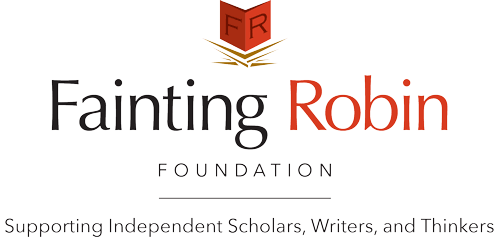Our Mission
Fainting Robin Foundation provides financial support to independent scholars, writers, and thinkers whose work falls outside the mainstream. Fainting Robin Foundation is a scholar-led, nonpartisan, nonprofit organization that rewards genuinely independent intellectual work.
Over the last fifteen years, support for independent scholarship outside an increasingly narrow mainstream has vanished. “Publish or perish” has devolved into “publish and perish” because most academic presses, magazines, and online publications pay, at best, NAFTA inspired wages for writing, photography, and fine art—the “content”—that fills their pages. All of the creative professions are under siege from the new economic model that rewards those who monetize the creations of others, but does not reward the actual creators. During the past two decades, writers, artists, musicians, and photographers have become subordinate to and dependent on “free rider monopoly platforms” like Google, YouTube, Facebook, and Amazon. As Jonathan Taplin put it in The New York Times, “The rise of the digital giants is directly connected to the fall of the creative industries in our country.”1
Why should anyone be surprised that Americans read and believe “fake news” given the declining state of the American media? Journalists were once paid by the word; they received royalties and payments from the sales of foreign rights. Today, that is no longer the case. According to a 2015 Careercast survey, newspaper reporter edged out lumberjack as the worst job in America. Although Facebook and the partisan websites provide convenient straw men for “fake news” critics, we should not forget that The New York Times published Jason Blair’s and Judith Miller’s serial fabrications. “New media” outlets (Huffington Post, Vice, and many others) have replaced professional, career reporters with untrained amateurs who are willing to forgo fair pay in exchange for exposure. “The average reporter we talk to is 27 years old, and their only reporting experience consists of being around political campaigns. That’s a sea change. They literally know nothing,” explained former National Security Advisor and journalist Ben Rhode. With the 24-hour news cycle, what passes for journalism today is largely public relations. National consciousness is no longer determined by exposure to intellectual quality, but by popularity in the form of Internet traffic and mysterious algorithms understood only by Google. Internet and virtual reality pioneer Jaron Lanier laid bare the implications of this model: “Funding a civilization through advertising is like trying to get nutrition by connecting a tube from one’s anus to one’s mouth. The body starts consuming itself. That is what we are doing online.” 2
American higher education is following a similar model of profit maximization. Although college and university tuitions have tripled since 1975, very little money has been spent on teachers. Like our banks, our institutions of higher learning, backed by nondefault student loans, have engaged in economic speculation. Financially leveraged and often operating on lines of credit, they, like so many other American businesses, balance their books by relying on part-time labor. For “adjunct” or “contingent” academics, contemporary higher education has more in common with the meatpacking industry than with the world of ideas and scholarship. Despite the progressive rhetoric, American colleges and universities have embraced black market labor practices that were once confined to agriculture in California. As bad as the low pay and lack of benefits is the perpetual insecurity of leading life one semester at a time. The future for most academics, especially in the humanities, is bleak. Very soon only a small minority of academics will have full-time employment, much less tenure and the intellectual freedom it once ensured. Seventy-five percent of university and college faculties are part-time workers who are not on tenure tracks and never will be. Although they often carry the same workload as their full- time colleagues, part-timers are paid an average of $2,700 per class and make less than $30,000 per year. A fast-growing number of part-time professors live at or below the poverty line, (one in four is on some form of federal assistance). Fainting Robin Foundation will support marginalized scholars and writers—many with hard-earned PhDs and a lifetime of fieldwork—who are drowning in debt and uncertainty.3
